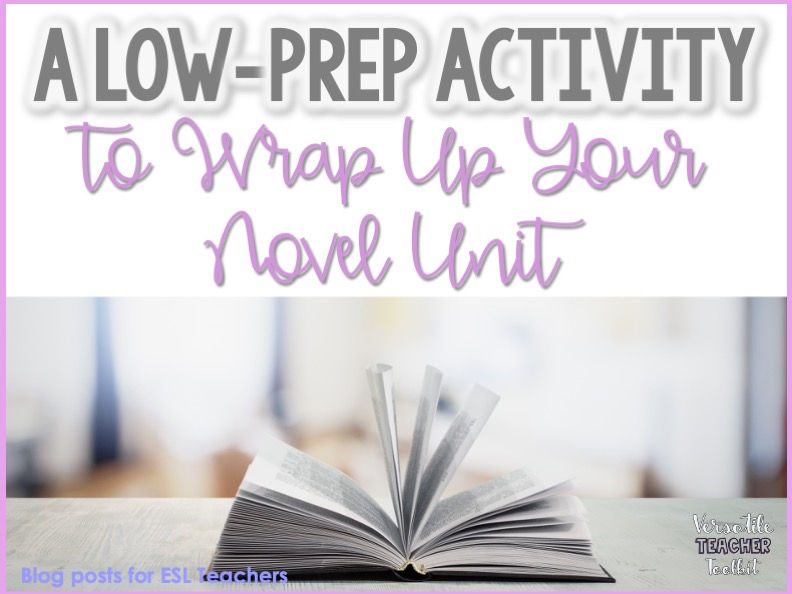How to Successfully Implement the Response Process in Your ESL Class
- Kynga C.

- May 13, 2019
- 4 min read
Updated: Dec 29, 2022

To turn a novel study unit into an engaging learning experience in our ESL classes, we need to choose a book that is motivating, relevant and accessible to our learners’ proficiency level. I often select novels that have universal themes such as overcoming challenges, determination, loyalty, acceptance, identity, courage, heroism, coming of age, power and corruption, and individual versus society because I know that my students will be able to relate to these ideas.
Exploring literary works with English language learners
When teaching a piece of literature, there are some models we might want to consider:
cultural model
language model
personal growth model
The language and personal growth models are student-centered approaches; therefore, they are more appropriate for ESL classes. These two models help us to expose our learners to language as well as to encourage them to draw on their opinions, feelings, and personal experience. In addition, providing the socio-historical context of any of the assigned novels is also important to help our learners construct meaning.
Using reading journal entries to help learners make personal connections with the text
I admit that I favour the personal growth model. This strategy is extremely easy to implement during independent reading periods if you do not have time to create teaching materials for your chosen text. Plus, it is also a good alternative to boring worksheets that your students might dread completing.
When using reading journal entries, learners simply need a reading journal (a notebook) so that they take notes while reading. Before each reading period, the teacher indicates what learners need to focus on in a particular chapter or section of the novel. These could be: theme, tone, narrative point of view, setting, characters’ values and principles, symbols, character growth, conflict situations, so on and so forth.
However, before requiring my learners to record their reactions, opinions, feelings, and comments based on the above prompts in their reading journal, it is important to show them how to engage with a text in a meaningful way. Learners need to be able to ask the right questions while reading so they critically approach the text and build relationships and connections about a given theme or concept to construct meaning. You may find a helpful response to text guide in my TpT store How-to Guide to Reacting and Responding to Fiction and Nonfiction.
Helping learners to develop high-order thinking skills
For instance, when I was teaching The Outsiders and The Giver, I asked my students to concentrate on the following concepts while reading (See the chart below). I also expected them to form opinions and connect with the text by drawing on their own experience.
Concepts/themes to focus on while reading The Outsiders and The Giver:
The Outsiders - Focus on:
Ponyboy’s character
Ponyboy’s relationship with Johnny and his brothers
the differences between the Socks and the greasers
Ponyboy’s loyalty
Ponyboy and Johnny hiding
heroism, friendship so on and so forth.
The Giver - Focus on:
Jonas’s world/community
the things that are missing from Jonas’s world
the importance of the Ceremony of twelve
the freedom of choice
the concept of the family unit
utopia/dystopia
Jonas’s evolution, so on and so forth.
Although this activity is very easy to implement, yet, in its simplicity, it requires students to complete a quite complex task as they need to show their understanding of the text, think critically, and establish a personal connection with the text by drawing on content knowledge and personal experience.
To help learners develop higher-order thinking skills during the response process, you may target the following reading skills and strategies:
predicting
reading for details
determining vocabulary using context clues
drawing conclusions
comparing and contrasting
determining character motive
reflecting on reading
Focusing on both language and personal growth models while teaching literature
Although focusing on the personal growth model helps learners develop the skills needed to genuinely connect with the text and reflect on various aspects of the book, we should not neglect the benefit of using the language model to help learners improve their grammar skills, especially in ESL classes.
For instance, I incorporated both the language and personal growth models while teaching The Strange Case of Dr. Jekyll and Mr. Hyde. In order to engage my students in the response process, I included both text-dependent questions to verify comperehension and open-ended questions requiring them to think critically and to form opinions about the characters, situations, and events. Needless to say, teaching grammar in context while reading the novel was a game changer. Not only were learners actively exploring the novel with the help of graphic organizers and various oral interaction and writing activities, but they were also focusing on the usage of past tense, conditional sentences, modal auxiliaries, adjectives, and degrees of comparison.
If you love teaching The Strange Case of Dr. Jekyll and Mr. Hyde as much as I do, you might like to take a look at this classroom-tested unit here: Dr. Jekyll and Mr. Hyde Novel Study Guide with Answer Key.
Final Thoughts
Teaching the response process is not difficult, but it takes time. I have successfully implemented this reading strategy in ESL classes where learners were used to completing reading comprehension questions without knowing how to connect with the text. For years, I’ve been committed to developing and implementing effective reading strategies to improve my learners’ performance, and I have managed to reach this goal by offering direct instruction (modelling) and plenty of opportunities to practise. If you are looking for a hands-on resource to have your learners pactise the active reading model, you can download my free Active Reading Strategy Task Cards and Worksheets from my TpT store by clicking here.
Happy teaching!
Kynga C.









Comments